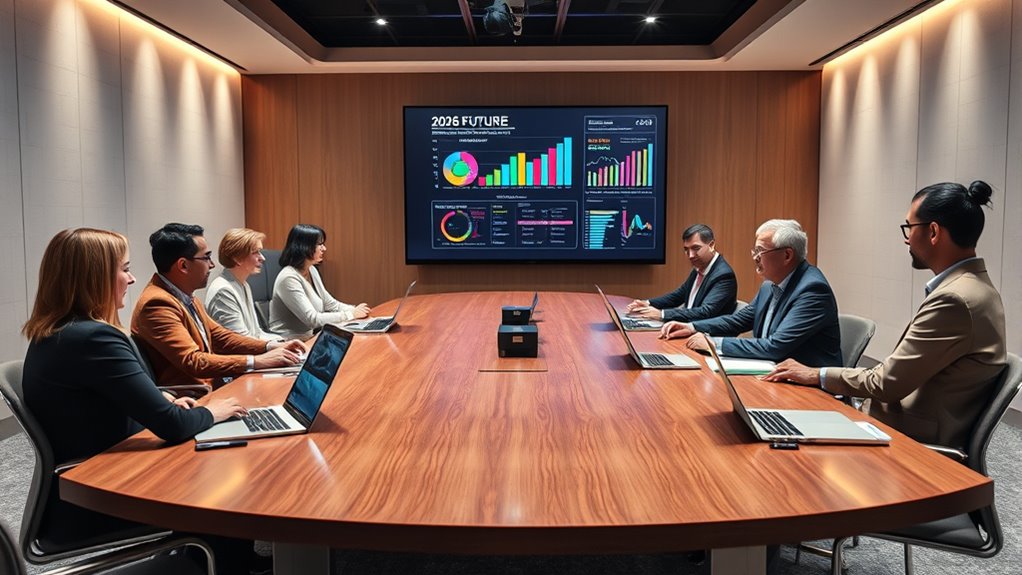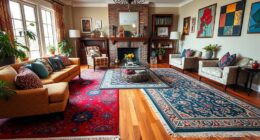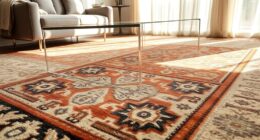The rug market is expected to grow considerably by 2026, fueled by demand for eco-friendly, stylish, and technologically advanced products tailored to regional preferences. Consumers seek sustainable fibers, innovative designs, and smart features, creating new opportunities for manufacturers. Regional trends vary, with luxury and artisanal rugs in the Middle East and eco-conscious options in North America. Exploring these insights further reveals how innovation and digital strategies will shape the industry’s future.
Key Takeaways
- The global rug market is projected to reach new heights by 2026, driven by rising demand for home decor and interior upgrades.
- Sustainability trends, including eco-friendly materials and innovative dyeing techniques, significantly influence consumer preferences and product development.
- Technological innovations like smart, interactive rugs are enhancing user experience and integrating rugs into connected home ecosystems.
- Regional dynamics show North America focusing on luxury and eco-friendly rugs, while Asia’s urbanization boosts affordable, stylish options.
- E-commerce advancements, such as virtual showrooms and personalized online tools, are transforming sales channels and customer engagement worldwide.
Market Size and Growth Projections for 2026

The global rug market is expected to reach new heights by 2026, driven by increasing demand for home decor and interior design upgrades. As a consumer or retailer, you’ll notice growth fueled by expanding retail distribution channels that make rugs more accessible worldwide. However, this growth isn’t without challenges; import tariffs can impact prices and supply chains, influencing purchasing decisions. Higher tariffs on imported rugs might limit options or increase costs, affecting market dynamics. Conversely, countries with favorable trade policies could see accelerated growth, boosting local production and exports. Staying informed about these trade policies helps you anticipate shifts in supply and pricing. Additionally, market transparency is essential for consumers and businesses to navigate the evolving landscape effectively. Moreover, market players are exploring innovative materials and designs to differentiate their offerings amidst increasing competition. Furthermore, improvements in manufacturing technologies are enabling more efficient production processes and higher-quality products. Overall, despite potential hurdles, the market’s growth projections remain strong, promising more diverse options and opportunities for growth in the coming years.
Emerging Design Trends and Consumer Preferences
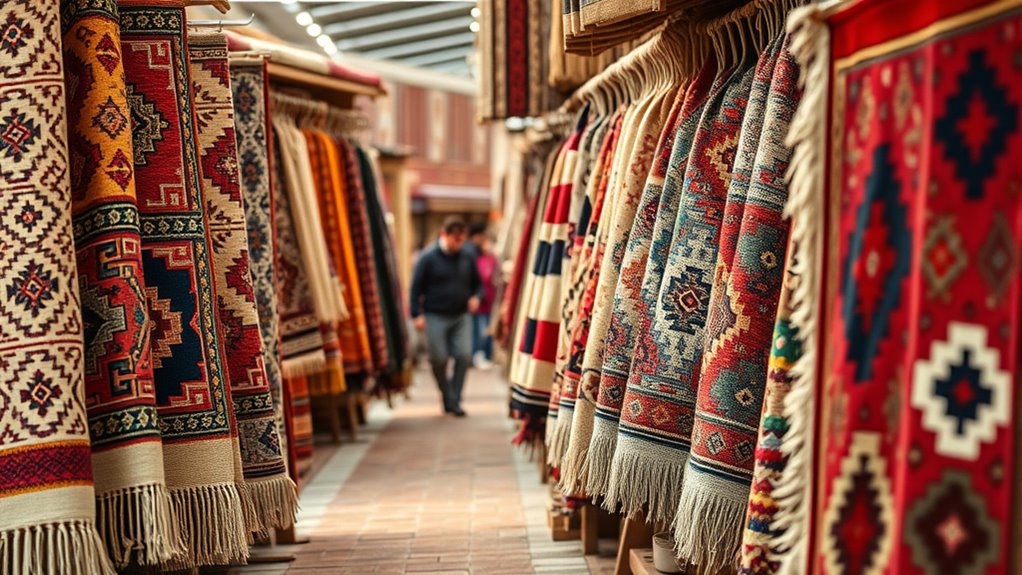
You’ll notice that eco-friendly materials are becoming more popular as consumers seek sustainable options. Mindfulness practices can help designers and consumers alike develop a deeper appreciation for ethically produced and environmentally conscious rugs. Bold patterns are also gaining traction, reflecting a desire for statement pieces in home decor. These trends show that both environmental consciousness and bold aesthetics are shaping the future of rug design. Additionally, understanding IRA tax implications can help consumers make more informed purchasing decisions for their investments. Incorporating sustainable sourcing practices is increasingly important to meet consumer demand for ethically produced rugs. Recognizing how creative practice encourages innovative solutions can inspire designers to push the boundaries of traditional rug patterns and textures.
Eco-Friendly Materials Rise
As awareness of environmental issues grows, consumers increasingly seek rugs made from eco-friendly materials. You’ll notice a shift toward sustainable choices, emphasizing eco-conscious production. Here are key trends shaping this movement:
- Using sustainable dyeing techniques reduces water and chemical use, appealing to eco-aware buyers.
- Recycled fibers, like PET or reclaimed wool, are becoming popular for their reduced environmental impact.
- Natural materials such as jute, sisal, and organic cotton are gaining traction for their biodegradability.
- Transparent sourcing and eco-labels help consumers make informed choices about environmentally friendly rugs.
Bold Pattern Preferences
With consumers increasingly drawn to eye-catching designs, bold pattern preferences are shaping the future of rug aesthetics. You’ll notice a rise in vibrant, striking patterns that make a statement in any space. While minimalism remains popular, bold patterns now take center stage, reflecting a desire for individuality and visual impact. Traditional motif popularity is also evolving; classic designs are being reimagined with modern twists, blending heritage with contemporary flair. This shift indicates that consumers want rugs that stand out and tell a story, whether through geometric shapes, large florals, or abstract motifs. As a result, manufacturers are focusing on creating daring, memorable patterns that appeal to those seeking unique, conversation-starting pieces for their homes. Additionally, the design trends seen in other interior spaces, such as farmhouse bedrooms, emphasize the importance of bold yet cohesive visual elements to create a distinctive and inviting atmosphere. Incorporating textured fabrics and other creative textile techniques can inspire innovative pattern designs that resonate with consumers seeking personalized and expressive decor. Understanding consumer preferences is crucial for designers aiming to meet the demand for statement pieces, and staying updated on industry innovations can provide a competitive edge in developing appealing designs.
Impact of Sustainability and Eco-Friendly Materials

The growing emphasis on sustainability is reshaping the rug market, compelling manufacturers to prioritize eco-friendly materials. You’ll notice a shift toward products that incorporate recycling initiatives and biodegradable fibers. These efforts help reduce environmental impact and appeal to eco-conscious consumers. Specifically:
- Manufacturers are integrating recycled materials to create durable, sustainable rugs.
- Biodegradable fibers are gaining popularity for their ability to break down naturally.
- Recycling initiatives are encouraging the reuse of fabric and textile waste.
- Consumers are increasingly demanding eco-friendly options, driving innovation in sustainable rug design.
- Incorporating fraud detection techniques into supply chain management can help prevent counterfeit or compromised materials from entering production.
- Implementing quality control measures ensures that eco-friendly materials meet safety and durability standards, fostering consumer trust and supporting sustainable manufacturing practices.
Technological Innovations in Rug Manufacturing
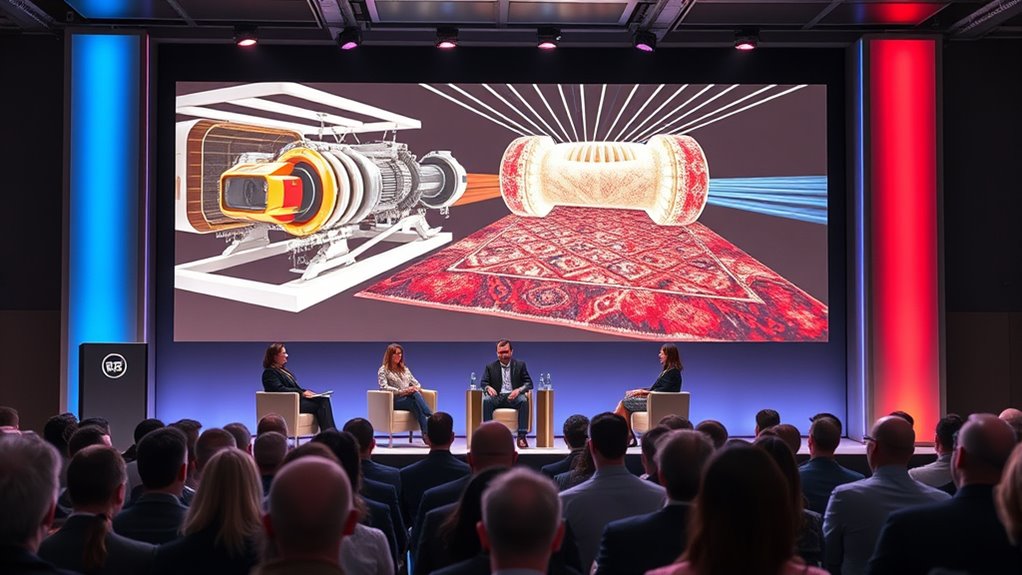
Technological innovations are transforming rug manufacturing, making processes more efficient and customizable. Smart rug technologies allow for interactive features and remote control options that enhance user experience. Additionally, advancements in sustainable manufacturing methods help reduce environmental impact while maintaining quality. Incorporating environmentally friendly practices into the design process can foster better collaboration among teams, leading to more innovative product development.
Smart Rug Technologies
Smart rug technologies are transforming the way rugs interact with their environment and users. You’ll notice advanced features like embedded sensors that detect motion, temperature, or even spills. These rugs offer interactive features that adapt to your lifestyle, enhancing convenience and safety.
- Sensor integration allows rugs to respond automatically, such as adjusting lighting or activating alarms when movement is detected.
- Interactive features enable voice commands or app control, giving you easy access to customize your rug’s functions.
- Some rugs monitor indoor air quality, providing real-time feedback to improve your living space.
- Innovative designs now incorporate touch-sensitive surfaces, allowing you to control devices or access information seamlessly.
These technological advancements make smart rugs more than just decor—they’re an integral part of your connected home.
Sustainable Manufacturing Advances
As awareness of environmental impact grows, rug manufacturers are adopting innovative sustainable practices to reduce waste and energy consumption. These advances in sustainable manufacturing include using eco-friendly materials like recycled fibers and natural dyes, which lower environmental footprints. You’ll see more companies integrating energy-efficient machinery and waste-reducing processes into their production lines. Eco-conscious practices also involve designing rugs for durability, promoting longer product lifespans and reducing overall waste. By prioritizing sustainable manufacturing, manufacturers can meet consumer demand for eco-friendly products while minimizing ecological impact. These technological innovations not only support environmental goals but also enhance brand reputation and market competitiveness. As the industry shifts, adopting these sustainable methods becomes essential for staying relevant and responsible in the evolving rug market.
Regional Market Dynamics and Opportunities
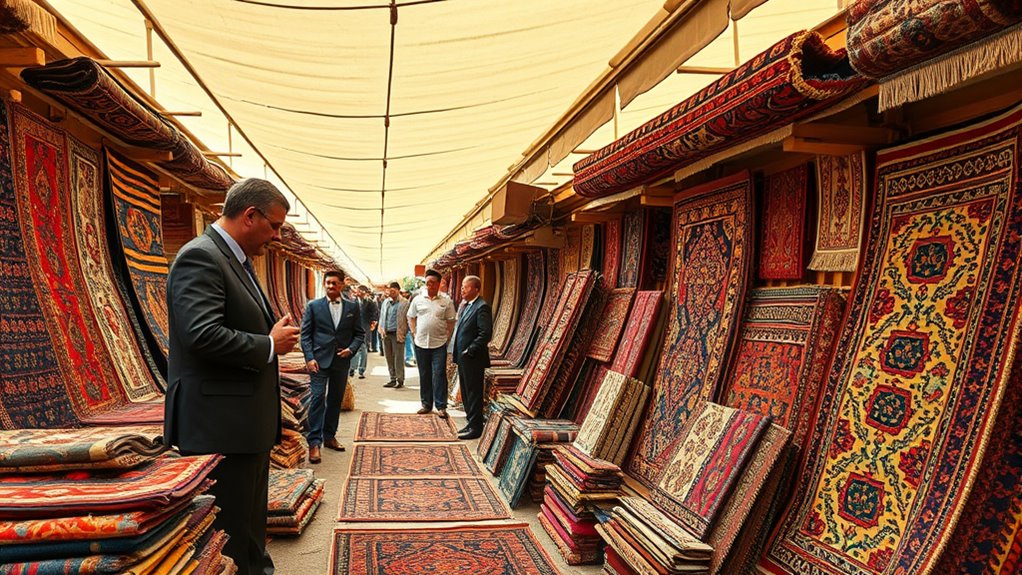
Regional market dynamics substantially influence the growth prospects and investment opportunities within the global rug industry. Understanding regional market nuances and demographic influences helps you identify key trends and consumer preferences.
- In North America, rising interest in luxury and eco-friendly rugs creates premium segment opportunities.
- In Asia, rapid urbanization and expanding middle classes boost demand for affordable, stylish rugs.
- European markets emphasize cultural heritage and craftsmanship, favoring artisanal and traditional designs.
- Middle Eastern regions prioritize luxury and exclusivity, making high-end, handcrafted rugs highly sought after.
Challenges and Risks Facing the Industry
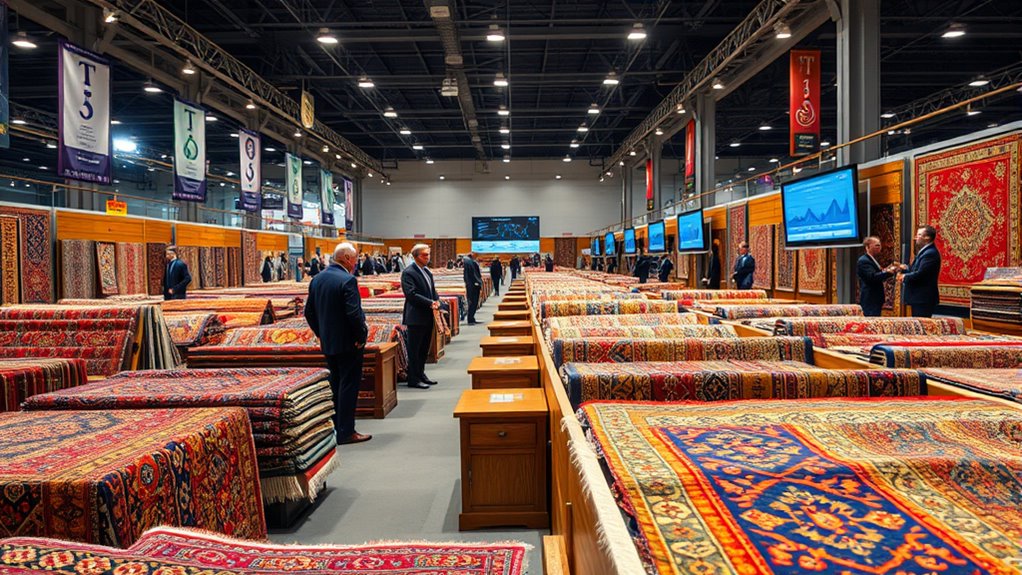
The rug industry faces several significant challenges that could impact growth and profitability. Supplier disruptions are a primary concern, causing delays and increasing costs for raw materials. Raw material shortages, especially of natural fibers like wool and cotton, threaten production stability and product quality. These issues often lead to increased prices, which can reduce consumer demand and squeeze profit margins. Additionally, geopolitical tensions and transportation disruptions further complicate supply chains. Staying adaptable is essential; failure to address these risks may result in missed market opportunities and financial setbacks. You need to monitor global supply trends closely and develop contingency plans to mitigate these risks, ensuring your operations remain resilient amid ongoing industry challenges.
E-commerce and Digital Transformation Strategies
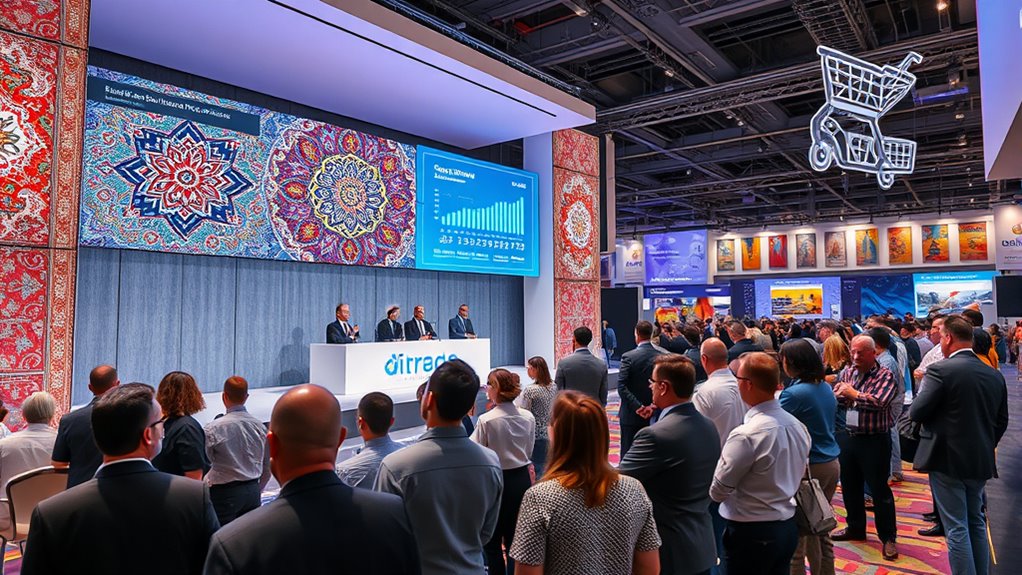
Embracing e-commerce and digital transformation is essential for staying competitive in the evolving rug industry. You can leverage virtual showrooms to showcase your collections globally, making it easier for customers to browse from home. Online customization options allow clients to select sizes, patterns, and colors, increasing satisfaction and engagement. To succeed, consider these strategies:
- Develop immersive virtual showrooms that mimic in-store experiences.
- Implement user-friendly online customization tools for personalized orders.
- Optimize your website for mobile devices to reach a broader audience.
- Use data analytics to understand customer preferences and tailor your offerings.
These digital strategies help you meet customer expectations and streamline sales, ensuring your business remains relevant in a competitive landscape.
Key Players and Competitive Landscape
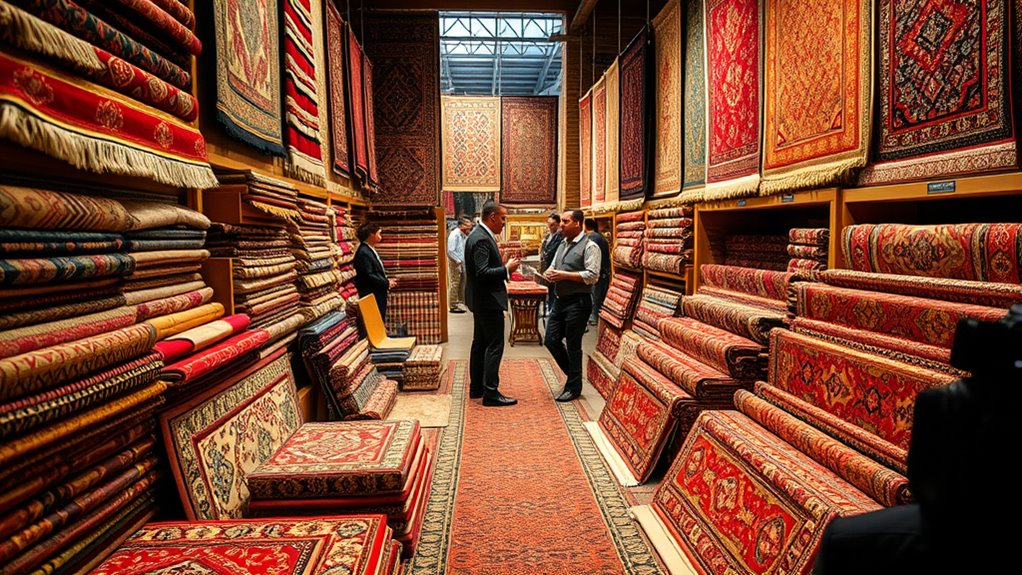
As the rug industry becomes increasingly competitive, understanding the key players and their strategies is essential for staying ahead. Major companies like Company A, B, C, D, and E dominate based on market share. They leverage competitive strategies such as product innovation, branding, supply chain efficiency, and regional expansion. Recognizing their strengths helps you anticipate market shifts and identify opportunities.
| Company | Market Share | Competitive Strategy |
|---|---|---|
| A | 25% | Innovation & premium branding |
| B | 20% | Cost leadership & global sourcing |
| C | 15% | Niche marketing & customization |
| D | 10% | Digital marketing & e-commerce focus |
| E | 8% | Sustainability initiatives |
Strategic Recommendations for Industry Stakeholders

To succeed in the increasingly competitive rug industry, stakeholders must adopt targeted strategies that leverage their strengths and address market trends. First, strengthen retail partnerships to expand reach and improve distribution channels. Second, focus on clear brand positioning to differentiate your offerings and resonate with target audiences. Third, invest in market research to stay ahead of consumer preferences and adapt accordingly. Fourth, innovate through sustainable materials and design to appeal to eco-conscious buyers and stand out in a crowded marketplace. By prioritizing retail collaborations and refining your brand positioning, you’ll build stronger market presence and customer loyalty. These strategic moves will help you navigate the evolving landscape and achieve long-term growth in the rug industry.
Frequently Asked Questions
How Will Global Economic Shifts Affect the Rug Industry by 2026?
Global economic shifts will likely impact your rug industry by prompting market diversification and emphasizing supply chain resilience. You’ll need to adapt to changing demand patterns and source materials more strategically. Strengthening supply chain resilience helps ensure steady production and delivery, even amid economic fluctuations. By staying flexible and diversifying your markets, you can better navigate uncertainties and maintain growth toward 2026.
What Are the Most Promising Emerging Markets for Rug Sales?
This question is a true goldmine for discovering new opportunities. You’ll find that emerging markets like Southeast Asia and Africa are booming, driven by a demand for artisanal craftsmanship and sustainable sourcing. These regions are experiencing rapid growth, making them perfect for expanding your rug sales. By tapping into local craftsmanship and emphasizing eco-friendly materials, you can establish a strong foothold in these promising markets, outpacing competitors and shaping future trends.
How Do Cultural Trends Influence Rug Designs and Consumer Choices?
You see that cultural trends strongly influence rug designs and consumer choices. Cultural symbolism and traditional motifs often inspire new patterns, making rugs more meaningful and personalized. When you choose a rug, you’re not just picking a decorative piece but also reflecting cultural heritage or modern reinterpretations. These trends help you connect with diverse backgrounds, ensuring your selection aligns with your values and aesthetic preferences, fostering a deeper appreciation for the craftsmanship.
What Role Will Artificial Intelligence Play in Rug Customization?
AI integration will revolutionize rug customization by enabling you to create unique designs effortlessly. As customization trends grow, AI tools can analyze your preferences and suggest personalized options, making the process faster and more intuitive. You’ll have the power to experiment with colors, patterns, and textures in real-time, ensuring your rug reflects your style perfectly. This technology makes custom rugs more accessible, enhancing your ability to craft truly one-of-a-kind pieces.
How Can Small Manufacturers Compete With Major Global Brands?
To compete with major global brands, focus on niche branding and craft differentiation. You can highlight your unique designs, personalized services, and local craftsmanship that big players often overlook. By emphasizing quality and authenticity, you create a loyal customer base that values your distinct offerings. Use social media and direct engagement to showcase your story and craftsmanship, making your rugs stand out in a crowded market, even against larger competitors.
Conclusion
By 2026, the rug market is set to flourish like a vibrant tapestry, woven with innovation, sustainability, and digital growth. Embrace emerging trends and technological advancements to stay ahead of the curve. Keep an eye on regional shifts and consumer preferences, as they’re the compass guiding your success. With strategic agility, you can turn challenges into stepping stones, ensuring your place in this dynamic industry’s colorful future. The rug is about to be pulled in your favor!
